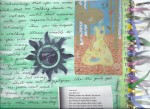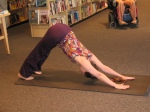I’m still continuing posts for Nanowrimo, focused on craft, since it’s not over yet, is it?
Remember something about the art of writing: It is the only art form that is not sensual. I’m not saying you can write sensual material, but rather the way the art impacts your senses. You can see the colors and strokes that make a painting, feel a sculpture, and hear music. The manner in which each individual piece in those fields impacts on the senses is different. But every writer uses the same letters on a piece of paper. You have twenty-six letters that combine to form words, which are the building blocks of your sentences and paragraphs. Everyone has the same words, and when I write that word and you write it, that word goes into the senses of the reader in the same way. It’s how we weave them together that impact the conscious and subconscious mind of the reader that makes all the difference in the world.
A book comes alive in the reader’s mind. You use the sole medium of the printed word to get the story from your mind to the reader’s. It is the wonder of writing to create something out of nothing. Every book started with just an idea in someone’s head. Isn’t that a fantastic concept?
Writers learn by writing. And before that, by being voracious readers.
In essence, writing is no different from any other profession. It’s a simple rule, but one that every one wants to ignore: the more you write, the better you will become. Practically every author I’ve ever talked to, or listened to, or read about in an interview, says the same thing. I saw Stephen King on C-Span and he said the most important thing to do to become an author is to write a lot. That is one of the reasons so many people are participating in this month’s Nanowrimo. One writing professor said you needed to write a million words before expecting to get published. I’m currently around word five million and still learning so much.
Let’s look at the positive side: The odds are strongly against getting published. But simply by taking the time and the effort to learn from these words and participating in Nanowrimo, you are increasing your odds. By continuing to write beyond your first manuscript, you vastly increase your odds. Many writers gush over the amount of money John Grisham made for The Firm but they forget that A Time To Kill was published previously to lackluster sales and failed. What is important to note about that was that Grisham realized he hadn’t done something right and worked hard to change. Note that Grisham did not sit still and bemoan what his agent/editor/publisher etc. didn’t do to help the novel. He didn’t complain that the reading public didn’t understand his brilliance. He worked on the one person he knew he could change: himself (a tenet of Write It Forward).
From talking with other published writers, I have found it is common that somewhere between manuscript numbers three and six, comes the breakthrough to publication. How many people are willing to do that much work? Not many, which is why not many succeed and how you can vastly increases your chances of beating the odds. Publishers do not want to make a one-time investment in a writer. When a publisher puts out a book, they are backing that writer’s name and normally want to have more than one book in the pipeline. Multiple book contracts are very common; with their inherent advantages and disadvantages. As soon as you type THE END on your first manuscript (and I mean THE END after numerous rewrites), the absolute first thing you must do is begin writing your second. With self-publishing, I recommend having at l east three books before putting much time and effort into marketing, as I describe in this earlier blog post.
Publishing has changed drastically and there are new opportunities for writers to get their novels into the hands of their readers. Traditional publishing isn’t the only viable option for the 21st century author. Self-publishing is quickly becoming the new medium for mid-list authors, and new authors. Amanda Hocking self-published her way into a two-million dollar contract with St. Martins Press. Myself, Connie Brockway, Barry Eisler, LJ Sellers and JA Konrath have all either written ourselves out of NY contracts or turned down a NY contract and ventured out on our own and have been successful.
As someone who wants to be in the entertainment business, you have to study those who have succeeded and failed in that business. Read interviews with people in the arts and entertainment industries and you will find a common theme: a lot of years of sweat equity put in before the big “break” came. I’ve read of and heard actors and comedians talk about spending decades working in the trenches before they became famous. Musicians who sang back-up for years before becoming lead. Painters who toiled in squalor (and often died) before their work was recognized.
Study the lives of writers. Read interviews with authors and see what they say. Go to conferences and talk to them. Listen to them talk about several things: how they became authors, how they live, how they feel about writing, how they write. Many worked very strange jobs before getting published. Almost all struggled and spent many years of suffering before they succeeded. I say suffering in terms of financial or career terms, not in terms of the writing itself. Most writers enjoy writing.
People seem to think that writers are different and, while in some highly publicized cases they are, most published writers have spent many years slugging away before even their first novel was published.
Simple perseverance counts for a lot. I think many people with talent lack the drive and fall out of the picture and people with maybe not as much talent but more drive take their place. It’s the difference between having a growth mindset and a fixed mindset. People with talent often believe they know all they ever need to know, so therefore their mind is fixed. Those who believe there is always something more to learn, have a growth mindset.
Let’s get back to where I talked about people in other professions doing a work practicum. Besides writing novels and reading, the other advice I would give would be to attend conferences and workshops. It is a worthwhile investment of your time and money to go to workshops and conferences. Not just to learn, but also to network. Because of that, the first Write It Forward ‘short’ my publishing company released is How To Get The Most Out Of Your Time And Money At A Writer’s Conference.
A college student once interviewed me and she asked me what she could do to become a better writer. I replied with my usual “Write a lot,” then thought for a second, looking at this nineteen year old woman. Then I said: “Live a lot. Experience life, because that is what you are eventually going to be writing about.”
What things do you suggest writers do in order to help themselves become better writers?
My thanks to Bob Mayer for permission to repost this insightful blog.
There are five primary areas of practice to the Writer Wellness plan. Every other week I will post an idea for relaxation (Monday Meditation,) creative play (Tuesday Tickle,) fitness and exercise (Wednesday Workout,) journaling and misc. (Thursday Thought,) and nutrition (Friday Feast.)
 Meanwhile, remember to look for a digital or print copy of Writer Wellness, A Writer’s Path to Health and Creativity at Who Dares Wins Publishing, http://whodareswinspublishing.com.
Meanwhile, remember to look for a digital or print copy of Writer Wellness, A Writer’s Path to Health and Creativity at Who Dares Wins Publishing, http://whodareswinspublishing.com.
And check out these great blogs for ideas to keep your writing and publishing healthy and prosperous.
http://writeitforward.wordpress.com/ Bob Mayer
http://jenniholbrooktalty.wordpress.com/ Jenni Holbrook
http://warriorwriters.wordpress.com/ Kristen Lamb
http://inspiration4writers.blogspot.com/ Inspiration for Writers, Inc.
http://pentopublish.blogspot.com/ Natalie Markey
http://amyshojai.com Amy Shojai
 Check out my new website Joy E. Held
Check out my new website Joy E. Held
Have you subscribed to this Writer Wellness blog yet? Get email updates when a new post is added. Click “subscribe” and leave your email. That’s it and thanks in advance!
Be well, write well
 Something I recommend in Writer Wellness is looking back through old journals we’ve written. It’s a meta-cognitive exercise that actively engages our minds with the path we’ve taken while giving us a hint of where we could be headed. I don’t mean to sound contradictory or psychic. Reviewing what we’ve written in our journals is just a good healthy way to check in and see what’s missing and give ourselves the opportunity to think about how to fill in the gaps of life. For instance, I have looked back through journals I kept for 2011 and realized that something I enjoy is spending time with friends and I don’t get enough of it. I also noticed that I wrote about wanting to do more leisure activities such as attending sports events which I really love. Now I make time for more of these things in my life and consciously tell my inner critic that I don’t HAVE to have the toilets clean and all the laundry done before I can go out and play. Consequently I had a marvelous latter half of the 2011 because I didn’t miss a home football game at the college where I teach, and I invited seven friends out to lunch at the same time, and we had a splendid time!
Something I recommend in Writer Wellness is looking back through old journals we’ve written. It’s a meta-cognitive exercise that actively engages our minds with the path we’ve taken while giving us a hint of where we could be headed. I don’t mean to sound contradictory or psychic. Reviewing what we’ve written in our journals is just a good healthy way to check in and see what’s missing and give ourselves the opportunity to think about how to fill in the gaps of life. For instance, I have looked back through journals I kept for 2011 and realized that something I enjoy is spending time with friends and I don’t get enough of it. I also noticed that I wrote about wanting to do more leisure activities such as attending sports events which I really love. Now I make time for more of these things in my life and consciously tell my inner critic that I don’t HAVE to have the toilets clean and all the laundry done before I can go out and play. Consequently I had a marvelous latter half of the 2011 because I didn’t miss a home football game at the college where I teach, and I invited seven friends out to lunch at the same time, and we had a splendid time!


















